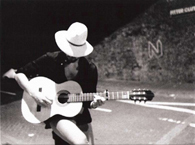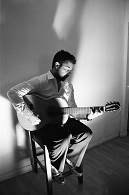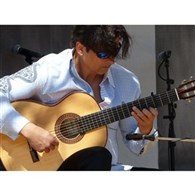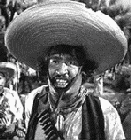Welcome to one of the most active flamenco sites on the Internet. Guests can read most posts but if you want to participate click here to register.
This site is dedicated to the memory of Paco de Lucía, Ron Mitchell, Guy Williams, Linda Elvira, Philip John Lee, Craig Eros, Ben Woods, David Serva and Tom Blackshear who went ahead of us.
We receive 12,200 visitors a month from 200 countries and 1.7 million page impressions a year. To advertise on this site please contact us.
|

|
|
RE: Which scales?
|
You are logged in as Guest
|
|
Users viewing this topic: none
|
|
Login  | |
|

   
kitarist
Posts: 1715
Joined: Dec. 4 2012

|
 RE: Which scales? (in reply to orsonw) RE: Which scales? (in reply to orsonw)
|
|
|
quote:
Adam Del Monte gives an explanation of what he is calling 'the comprehensive flamenco scale.'
Hmmm. His stated rationale for adding a D# is that it is the missing leading tone resolving to E from below (so it;s just like B resolving to C in C major). But a leading tone, a semitone from the tonic, does not have to resolve upwards to the tonic; his definition of a leading tone is too narrow and thus incorrect. A leading tone necessitates resolution towards the tonic regardless of whether from below or above. For E phrygian, we already have an existing diatonic leading tone - F (or Bb for A phrygian), which resolves DOWN to the tonic.
Careful readers  would have anticipated this from prior discussions where we had the visual representations of scales, noting that the phrygian scale is a mirror image of the major scale - hence the semitone away from the tonic is flipped, becoming the 2nd degree in phrygian, a semitone up from the tonic resolving down, compared to the 7th in major, a semitone down from tonic resolving up. would have anticipated this from prior discussions where we had the visual representations of scales, noting that the phrygian scale is a mirror image of the major scale - hence the semitone away from the tonic is flipped, becoming the 2nd degree in phrygian, a semitone up from the tonic resolving down, compared to the 7th in major, a semitone down from tonic resolving up.
Also, every time he mentioned 'mode', he actually meant a scale.
Another thing, I don't see what is the point of saying that the Am - G - F- E sequence is like i - VII - VI - V and call 'E" dominant as if in A minor tonality (and spending time emphasizing how E(7) resolves to Am). This is not A minor tonality though, it is E phrygian tonality, with the tonic E, thus E is I, and that sequence is iv - III - II - I proper. The reason we encounter it notated as i - VII - VI - V in western writing sometimes is because there everything is either major or minor; a system too narrow for flamenco.
Anyway just thinking about the things that will potentially confuse rather than clarify concepts.
_____________________________
Konstantin
|
|
|
|
REPORT THIS POST AS INAPPROPRIATE |
Date Apr. 12 2020 6:41:17
 |
|

   
Ricardo
Posts: 14799
Joined: Dec. 14 2004
From: Washington DC

|
 RE: Which scales? (in reply to kitarist) RE: Which scales? (in reply to kitarist)
|
|
|
quote:
Hmmm. His stated rationale for adding a D# is that it is the missing leading tone resolving to E from below (so it;s just like B resolving to C in C major). But a leading tone, a semitone from the tonic, does not have to resolve upwards to the tonic; his definition of a leading tone is too narrow and thus incorrect. A leading tone necessitates resolution towards the tonic regardless of whether from below or above. For E phrygian, we already have an existing diatonic leading tone - F (or Bb for A phrygian), which resolves DOWN to the tonic.
No his logic is correct, and you asked this before. The reason it works is Augmented 6 harmonic function/tritone sub, etc etc all discussed already. If he recognizes this literally I don’t know, but he should have stated it if he does see it. The issue for me is the D# is tied to F7 function in Arriba context, same as B7 in E major, but he never talks about F# in his “scale” so, introducing D# to students without the F7 function is leaving a lot out of it.
Next the andalusian cadence he addresses but it’s ambiguity (Am like burdo sees it, or E Phrygian? No difference?) we’ve also addressed. Traditional Flamenco never would cadence to an E7b9 chord...always a STABLE E triad. Modern Flamenco started adding those tensions as a final chord. To account for the same sequence functioning in two different tonalities, compas or phrasing needs to be discussed along with the stable tonic triad (NOT a dominant 7 equivalent) of the tradition that is part of justifying the practice (so people like burdo don’t have to feel it as an unresolved Am cadence).
In general yes you are right....there are confusing language and typical superficial harmonic explanations, buzz word traps, etc, as we have pointed out already that are super popular. To me he is at just 3 notes away from completing the scale picture, so why not go all the way? Nothing he said was “wrong” per say, simply incomplete and therefore misleading. I love how he starts running that 9 note scale all over the neck and suddenly has a look on his face “huh? That’s weird sounding wtf am I playing?” 🤪
_____________________________
CD's and transcriptions available here:
www.ricardomarlow.com
|
|
|
|
REPORT THIS POST AS INAPPROPRIATE |
Date Apr. 12 2020 17:45:49
 |
|

   
Ricardo
Posts: 14799
Joined: Dec. 14 2004
From: Washington DC

|
 RE: Which scales? (in reply to El Burdo) RE: Which scales? (in reply to El Burdo)
|
|
|
quote:
Otherwise, you might as well say that the characteristic scale of flamenco is the chromatic scale which defeats the purpose of trying to delineate the characteristics of a genre.
I said that exact thing on my first post. The reason, again, is that chromatic means there is NOT a single scale. It’s all scales and what gives character is the harmonic cadence which is very simply F-E...or F7-E.... or F9-E....stronger still F7#11-E. It’s all that simple...plus compas or phrasing.
quote:
All this classical harmony stuff (the various 6ths) is just so much tits on a bull to me. It may have weight but it is impenetrable enough to make me think it is probably wrong.
Well, Flamenco has Eastern sounding elements, but it uses chords and basic harmonic functions which are most simply understood via the western classical tonal harmony system. You can ignore that fact if it suits your personal path, but denying it is happening like it’s one crazy guys conspiracy theory, is doing disservice to others trying to understand what’s going on. It’s like looking at a map of Ohio and saying, “well yes there is some stuff outside those boundaries there, possibly, but this serves as a perfectly fine map representing the USA”.
_____________________________
CD's and transcriptions available here:
www.ricardomarlow.com
|
|
|
|
REPORT THIS POST AS INAPPROPRIATE |
Date Apr. 12 2020 18:00:16
 |
|

   
kitarist
Posts: 1715
Joined: Dec. 4 2012

|
 RE: Which scales? (in reply to Ricardo) RE: Which scales? (in reply to Ricardo)
|
|
|
quote:
No his logic is correct, and you asked this before. The reason it works is Augmented 6 harmonic function/tritone sub, etc etc all discussed already.
I thought he was arguing that normal E phrygian scale does not have a leading tone, so that's why he added an additional tone to the scale - D# - so the scale can have a leading tone. The implicit assumption there was that the usual E phrygian does not have a leading tone. But it does - F - so if he wanted to add D# anyway, he should have explained its addition with different arguments - in fact the argument about aug 6 harmonic function that you present.
So, more specifically, my objection here was to the rationale for adding it, rather than for whether D# works - it does as you say because, once you have it, it ALSO wants to resolve to E, and you provided the aug 6 framework to show that before.
_____________________________
Konstantin
|
|
|
|
REPORT THIS POST AS INAPPROPRIATE |
Date Apr. 12 2020 18:41:07
 |
|
 New Messages New Messages |
 No New Messages No New Messages |
 Hot Topic w/ New Messages Hot Topic w/ New Messages |
 Hot Topic w/o New Messages Hot Topic w/o New Messages |
 Locked w/ New Messages Locked w/ New Messages |
 Locked w/o New Messages Locked w/o New Messages |
|
 Post New Thread
Post New Thread
 Reply to Message
Reply to Message
 Post New Poll
Post New Poll
 Submit Vote
Submit Vote
 Delete My Own Post
Delete My Own Post
 Delete My Own Thread
Delete My Own Thread
 Rate Posts
Rate Posts
|
|
|
Forum Software powered by ASP Playground Advanced Edition 2.0.5
Copyright © 2000 - 2003 ASPPlayground.NET |
0.109375 secs.
|


 Printable Version
Printable Version














 New Messages
New Messages No New Messages
No New Messages Hot Topic w/ New Messages
Hot Topic w/ New Messages Hot Topic w/o New Messages
Hot Topic w/o New Messages Locked w/ New Messages
Locked w/ New Messages Locked w/o New Messages
Locked w/o New Messages Post New Thread
Post New Thread